The Stamford Historical Society Presents
Pride and Patriotism: Stamford’s Role in World War II
Online Edition
The Attack at Pearl Harbor
The Japanese attack at Pearl Harbor was a shock to those who experienced it. On 25 November 1941 a fleet including six aircraft carriers left Hitokappu Bay in the Kuril Islands under strict radio silence bound for Hawaii. The attack had been planned by Admiral Yamamoto Isoroku and was commanded by Vice Admiral Chuichi Nagumo. Escorting the task force were two battleships, 2 heavy cruisers and six destroyers and a large number of fleet submarines. Together they had a total of 441 planes including fighters, torpedo bombers, divebombers, and fighter bombers larger than any previous aerial strike force.
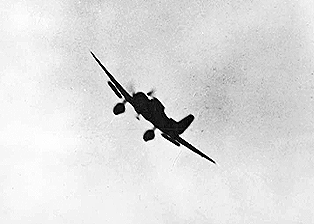
Japanese plane attacking Pearl Harbor (National Archives)
On 7 December the first wave of planes hit targets in the harbor at 7:53 AM. A second wave hit at 8:55 AM, and an hour later it was over. The attack left 2403 dead, 188 destroyed planes and a crippled Pacific Fleet. Twelve battleships had been badly damaged or destroyed. Of the Japanese attackers only 29 planes were lost in battle and another 20 were so badly damaged as to be irreparable.
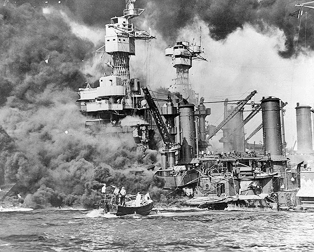
USS West Virginia after Pearl Harbor attack (National Archives)
Three hours later Japanese aerial attacks began directed at American targets in the Philippines.
The attack united American opinion in support of the War. Fortunately for the Americans, although the attack had inflicted great damage, the Pacific Fleet’s aircraft carriers, submarines and its fuel oil storage facilities were undamaged in the assault on Pearl Harbor.
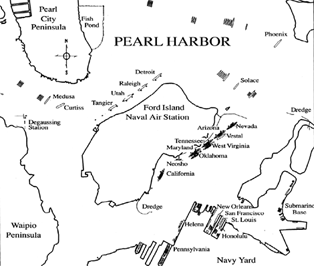
full-size image of map (pdf)
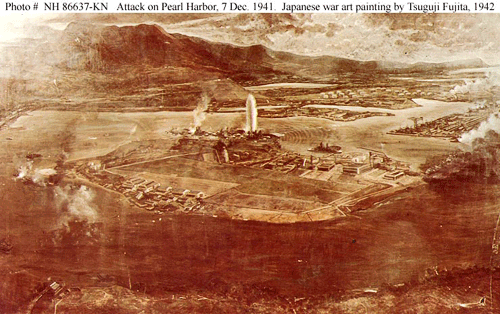
Pearl Harbor Attack, 7 December 1941
Japanese war art painting, in oils, by Tsuguji Fujita, 1942, depicting attacks around Ford Island.
The original painting measures about 2.7M by 1.7M.
Courtesy of the U.S. Air Force Art & Museum Branch (their accession # 277.53), 1978. U.S. Naval Historical Center Photograph.
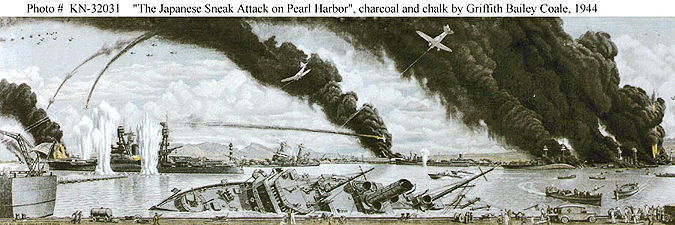
The Japanese Sneak Attack on Pearl Harbor.
Charcoal and chalk by Commander Griffith Bailey Coale, USNR, Official U.S. Navy Combat Artist, 1944.
Courtesy of the U.S. Navy Art Center, Washington, D.C. U.S. Naval Historical Center Photograph.
This artwork “… shows the destruction wrought on ships of the U.S. Pacific Fleet attacked in their berths by scores of enemy torpedo planes, horizontal and dive bombers on December 7, 1941. At the extreme left is the stern of the cruiser Helena, while the battleship Nevada steams past and three geysers, caused by near bomb misses, surround her. In the immediate foreground is the capsizing minelayer Oglala. The battleship to the rear of the Oglala is the California, which has already settled. At the right, the hull of the capzized Oklahoma can be seen in front of the Maryland; the West Virginia in front of the Tennessee; and the Arizona settling astern of the Vestal…, seen at the extreme right.
The artist put this whole scene together for the first time in the early summer of 1944, from 1010 Dock, in Pearl Harbor, where he was ordered for this duty. Coale worked under the guidance of Admiral William R. Furlong, Commandant of the Pearl Harbor Navy Yard, who stepped from his Flagship, the Oglala, as she capsized.” (quoted from the original Combat Art description).
The year of the exhibit marks 65th Anniversary of the United States entry into World War II. Let us always remember.
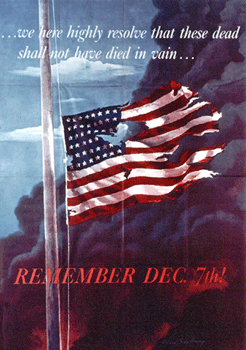
Poster designed by Allen Sandburg, issued by the Office of War Information, Washington, D.C., in 1942,
in remembrance of the Japanese Attack on Pearl Harbor on 7 December 1941.
The poster also features a quotation from Abraham Lincoln's Gettysburg Address:
“… we here highly resolve that these dead shall not have died in vain …”.
Courtesy of the U.S. Navy Art Center. Donation of Dr. Robert L. Scheina, 1970.
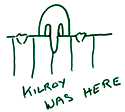 Introduction
Introduction
Veterans
Battles
Stamford Service Rolls
Homefront
Exhibit Photos
Opening Day


 Introduction
Introduction




